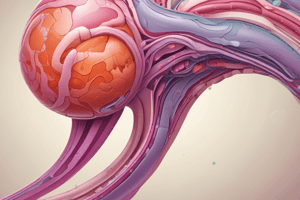Podcast
Questions and Answers
What is the function of the Fallopian tubes?
What is the function of the Fallopian tubes?
- To regulate hormones
- To support fetal development
- To connect the ovaries to the uterus (correct)
- To produce eggs
What is the role of estrogen in the female reproductive system?
What is the role of estrogen in the female reproductive system?
- To prepare the uterus for implantation
- To support fetal development
- To regulate the growth and development of the female reproductive system (correct)
- To induce ovulation
What occurs during the luteal phase of the menstrual cycle?
What occurs during the luteal phase of the menstrual cycle?
- The release of an egg from the ovaries
- The shedding of the uterine lining
- The preparation of the uterus for implantation (correct)
- The growth and development of follicles in the ovaries
What is the function of the cervix?
What is the function of the cervix?
What is polycystic ovary syndrome (PCOS)?
What is polycystic ovary syndrome (PCOS)?
What is menstruation?
What is menstruation?
What is the function of progesterone?
What is the function of progesterone?
What is infertility?
What is infertility?
Flashcards are hidden until you start studying
Study Notes
Overview
The female reproductive system is a complex system that enables women to produce eggs, nurture a fetus during pregnancy, and give birth.
Components
- Ovaries: Produce eggs (oocytes) and hormones such as estrogen and progesterone.
- Fallopian tubes: Tubes that connect the ovaries to the uterus, allowing eggs to travel to the uterus.
- Uterus: A muscular organ that supports fetal development during pregnancy.
- Cervix: The lower part of the uterus that opens into the vagina.
- Vagina: A muscular canal that connects the cervix to the outside of the body.
- Vulva: The external female genital area, including the labia, clitoris, and opening of the vagina.
Functions
- Ovulation: The release of an egg from the ovaries, usually once a month.
- Menstruation: The shedding of the uterine lining, occurring approximately every 28 days.
- Fertilization: The fusion of a sperm and an egg, resulting in a zygote.
- Pregnancy: The development of a fetus in the uterus, supported by the placenta and amniotic fluid.
- Childbirth: The process of delivering a baby from the uterus through the vagina.
Hormones
- Estrogen: Regulates the growth and development of the female reproductive system.
- Progesterone: Prepares the uterus for implantation of a fertilized egg and maintains pregnancy.
Menstrual Cycle
- Follicular phase: The growth and development of follicles in the ovaries, leading to ovulation.
- Luteal phase: The preparation of the uterus for implantation, following ovulation.
- Menstruation: The shedding of the uterine lining if pregnancy does not occur.
Pathologies
- Endometriosis: The growth of uterine tissue outside the uterus.
- Polycystic ovary syndrome (PCOS): A hormonal disorder affecting ovulation and fertility.
- Cervical cancer: A type of cancer affecting the cervix.
- Infertility: The inability to conceive or maintain a pregnancy.
Components of the Female Reproductive System
- Ovaries produce eggs (oocytes) and hormones such as estrogen and progesterone.
- Fallopian tubes connect the ovaries to the uterus, allowing eggs to travel to the uterus.
- The uterus is a muscular organ that supports fetal development during pregnancy.
- The cervix is the lower part of the uterus that opens into the vagina.
- The vagina is a muscular canal that connects the cervix to the outside of the body.
- The vulva is the external female genital area, including the labia, clitoris, and opening of the vagina.
Functions of the Female Reproductive System
- Ovulation is the release of an egg from the ovaries, usually once a month.
- Menstruation is the shedding of the uterine lining, occurring approximately every 28 days.
- Fertilization is the fusion of a sperm and an egg, resulting in a zygote.
- Pregnancy is the development of a fetus in the uterus, supported by the placenta and amniotic fluid.
- Childbirth is the process of delivering a baby from the uterus through the vagina.
Hormones and Their Functions
- Estrogen regulates the growth and development of the female reproductive system.
- Progesterone prepares the uterus for implantation of a fertilized egg and maintains pregnancy.
Phases of the Menstrual Cycle
- The follicular phase is the growth and development of follicles in the ovaries, leading to ovulation.
- The luteal phase is the preparation of the uterus for implantation, following ovulation.
- Menstruation occurs if pregnancy does not occur.
Pathologies of the Female Reproductive System
- Endometriosis is the growth of uterine tissue outside the uterus.
- Polycystic ovary syndrome (PCOS) is a hormonal disorder affecting ovulation and fertility.
- Cervical cancer is a type of cancer affecting the cervix.
- Infertility is the inability to conceive or maintain a pregnancy.
Studying That Suits You
Use AI to generate personalized quizzes and flashcards to suit your learning preferences.



